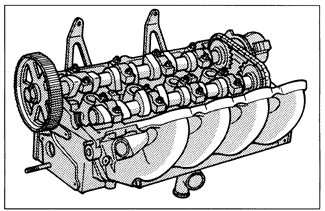Valve TrainThe camshafts are driven by the crankshaft via a single toothed, steel-reinforced belt. The belt drives a single sprocket attached to the exhaust camshaft. The exhaust camshaft in turn drives the intake camshaft through a roller chain and sprockets at the other end of the cylinder head. The drive belt and sprockets, although similar to those of the other four-cylinder engines, are modified to handle the extra loads of the 16-valve valve train. Fig. 1-3 shows the orientation of the camshafts and drive mechanisms in the assembled cylinder head. The cam lobes operate the intake and exhaust valves directly through hydraulic cam followers which use engine oil, supplied under pressure by the lubrication system, to maintain correct valve clearances. A spray-jet assembly, similar to that used to cool the pistons, is used in the cylinder head to prevent oil from draining out of the supply gallery for the cam followers. Sodium-filled exhaust valves aid heat transfer and reduce valve seat temperature. Dual valve springs and both upper and lower spring seats are used on the intake and exhaust valves.

|